Every year another impressive new coffee brewer hits the market. There are now so many different ways of preparing your morning cup of joe, it is almost difficult to know where to start! Despite all of the choice, I always find myself coming back to the Stovetop Moka Pot. When used properly, the Moka Pot produces delicious coffee that is just dripping with flavor and character, literally.
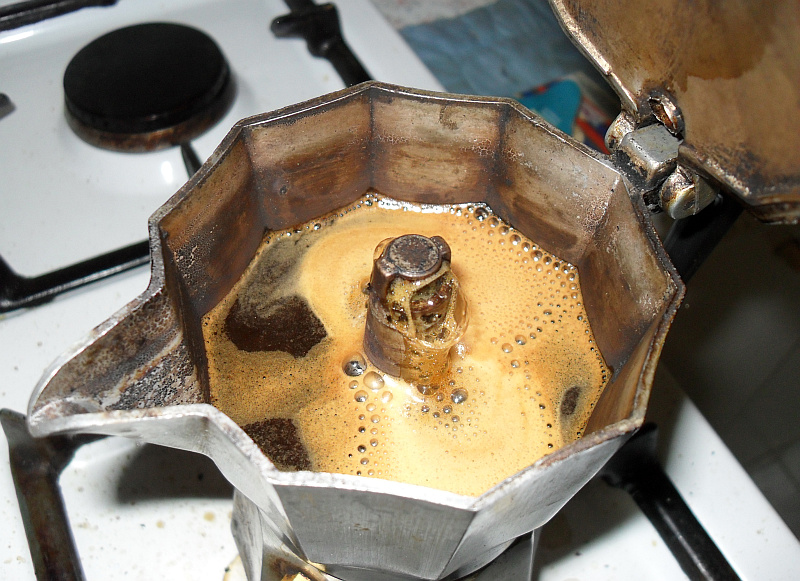
In this post, I will show you how to make stovetop espresso in a step by step guide. The guide can be used just as a simple reminder of the basics, or read it all to perfect your technique, and improve the taste of your cup of coffee.
My History with the Stovetop Coffee Maker
It took me a while to get the hang of my Stovetop Coffee Maker. In the beginning I was so frustrated, I just couldn’t get the hang of it. However, when I eventually cracked the code and perfected the recipe, I was amazed with the quality of Moka Pot coffee. I can now safely say it is my favorite way of brewing. The Stovetop Coffee Maker is classic, stylish and affordable. The only caveat is that you have to know the right technique for this particular brewer, otherwise it is easy to accidentally burn your morning java.
But let’s dive in by explaining the basics.
A Moka Pot is a classic coffee maker of Italian design, made from aluminum or steel. Since its invention nearly 100 years ago, this brewer has remained one of the staple ways of making home-brewed Italian coffee.
The macchinetta, as the Italians call it, was invented by Luigi de Ponti, and he patented it for Alfonso Bialetti in 1933. The same model is still sold today as Bialetti Moka Express. More history of the macchinetta here. The aluminum made octagonal coffee maker is the favorite way of making coffee for millions of people.
The Moka pot goes by various names, many times called stovetop espresso maker, is also called an Italian coffee maker, a coffee percolator, or a geyser coffee maker.
The Moka Pot is a manual brewer that simply requires a heat source to brew a cup of coffee. This can be in the form of electric stovetops, a gas stovetop or a camping gas burner, making the Moka Pot an ideal on-the-go coffee maker. The stainless steel models are also suitable for induction stoves. This manual coffee machine comes in a variety of sizes, which is perfect if you want to brew several cups of coffee at the same time.
Is Moka Pot an Espresso Maker?
Despite the fact that the Moka Pot is often referred to as a stovetop espresso maker, there is debate as to whether this brewer makes real espresso. An espresso coffee machine can create 9 bars of pressure during extraction, whereas the Moka pot can only create about 1.5 bars.
Furthermore, the coffee to water ratio is different from espresso. A traditional espresso is brewed at 1:2 coffee to water ratio, whereas the stovetop espresso is brewed at 1:7 ratio.
Your Moka pot makes an amazing concentrated coffee, a great espresso alternative, but with it’s own unique and complex character.
How Does Moka Pot Coffee Taste?
Many coffee lovers call Moka pot coffee espresso. The reality is that it tastes differently from espresso. The reason is the water temperature, which is hotter than the pump espresso, and the lower pressure during brewing. However, Moka pot coffee drinkers will tell you that it’s better than espresso.
Moka pot espresso is a rich coffee with a full body, with full notes of chocolate and caramel. There are also more bitter accents in a stovetop espresso.
If you love strong coffee, and you aren’t afraid of some bitter notes, this is definitely for you. If you add sugar to your coffee, you will fall in love with this brewing method. Italians use sugar with their coffee prepared in a macchinetta. Consider that a drip coffee is brewed at 1:16 coffee to water ratio, compared to our Moka pot at 1:7 ratio.
If you need an espresso-like coffee for your milk-based beverages, the stovetop espresso is a great option. The milk will mellow down the bite, and you will get a flavorful cup similar to the drinks at Starbucks. You can prepare a great cappuccino, or latte using the espresso brewed in a moka pot.
What Type of Coffee Should We Use with Our Stovetop Coffee Maker?
If you like a full bodied, strong coffee, pair your coffee pot with a luscious dark roast. If you prefer a milder coffee, you can balance the intense moka coffee flavor with a light roast.
The Different Parts of a Moka Pot
Your espresso stovetop has three major components:
- The lower chamber that holds the water, also called the boiler, is equipped with an over-pressure safety valve, designed to allow the built up pressure to release for your safety.
- The filter basket that holds the ground coffee, some people call it funnel. The filter basket gets inserted into the boiler.
- The upper chamber that holds the brewed espresso coffee, also called sometimes the kettle.
In fact there are a couple more smaller pieces such as the filter plate and the rubber gasket.
How To Make Stove Top Espresso – Brewing Method
Brewing coffee with a Moka pot is not very complicated, but there are a few tricks that you need to know if you want to make a great cup of coffee. Follow the steps below exactly, and you will be surprised how much better your stove top espresso coffee will taste.
Step 1 – Add Water in the Lower Chamber
Add warm water or hot water to the lower chamber and fill to just below the safety valve. Do not cover the safety valve as it releases pressure to prevent your pot blowing up. Filtered or spring water is the best.
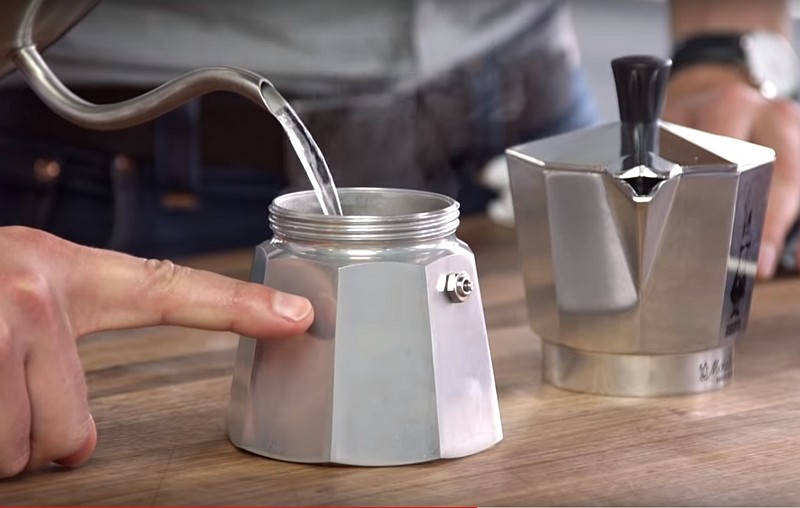
Step 2 – Grind Coffee
Grind coffee beans. The grind size is slightly coarser than espresso but definitely finer than drip. The range is between espresso and hand drip.
Step 3 – Add the Coffee Grounds in the Filter
Fill the filter basket with your freshly ground coffee. Apply gentle pressure and level the coffee in the basket. It’s important not to apply too much pressure or tamp the coffee, as a firm pack will increase the steam pressure. I prefer to fill the filter basket prior to placing it in the lower chamber.
Optional: Some people like their coffee clearer, if that’s you, place a round paper filter on top of the grounds.
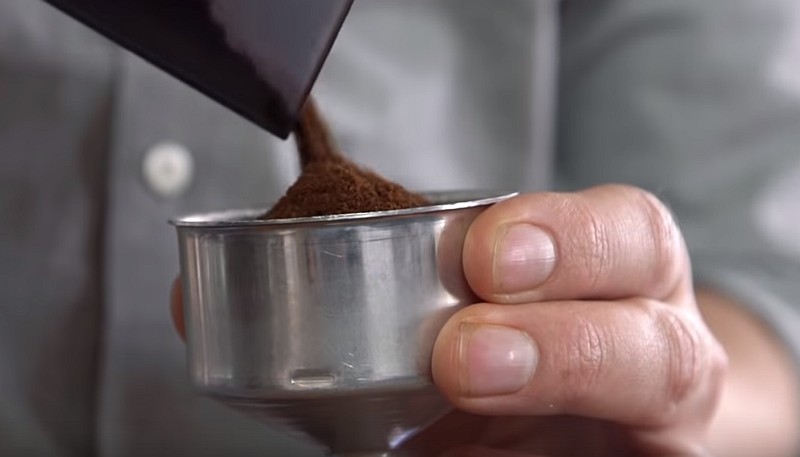
Step 4 – Assemble the Pot
Now it’s time to piece it all together. Place the filter basket in the lower chamber and screw on the top compartment.
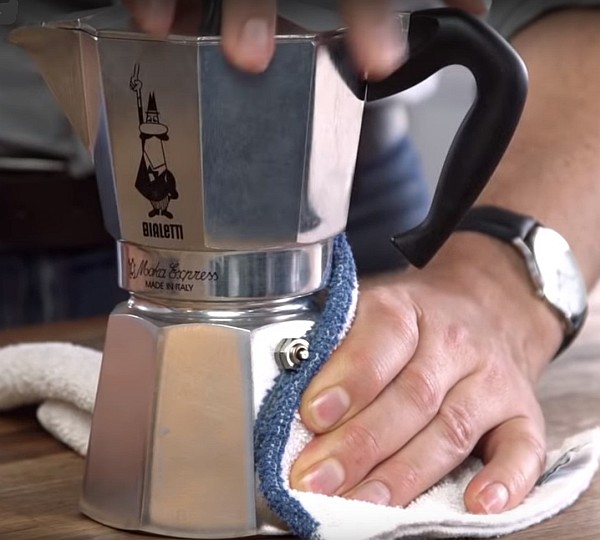
Step 5 – Start Brewing
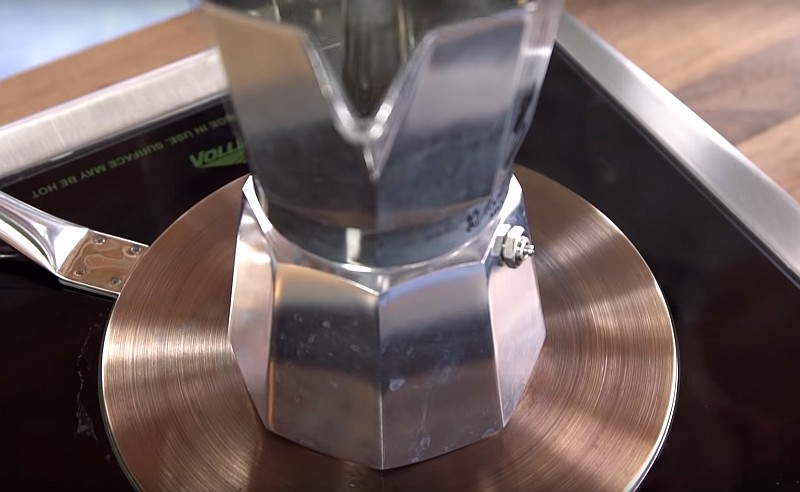
Step 6 – Stop Brewing
Once the the top compartment is full, remove from the stove and pour into your pre-heated cup of choice.
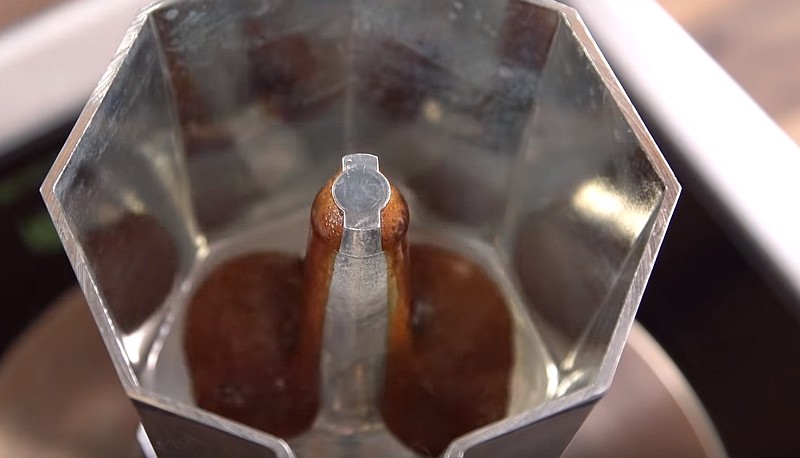
Once you hear a gurgling noise, it means all the water has passed into the top chamber. You need to stop the heat as soon as possible, as the longer coffee stays hot, the more bitter it becomes.
Step 7 – Cool off the Pot
Once you took it off the heat, place the Moka pot under the tap water and run some cold water until the pot cools down a little.
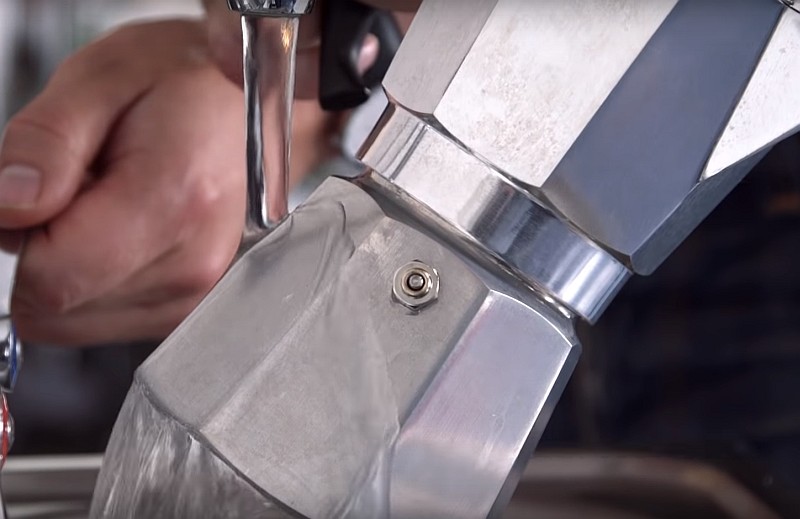
Pour in cups and enjoy
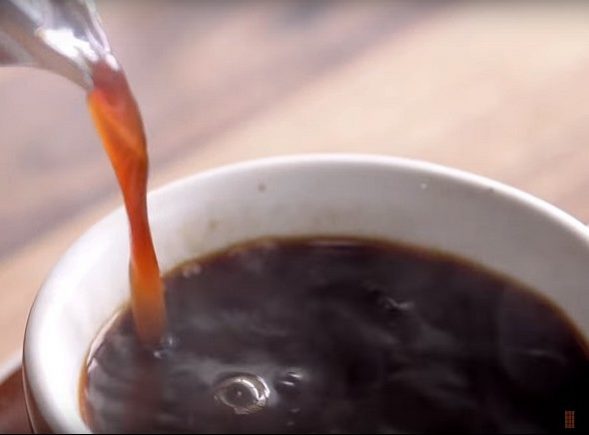
Moka Pot Troubleshooting
So you are following the steps but you are still not making good coffee with your Moka Pot. This could be for several reasons: First, make sure that the main body of the Moka Pot is tightly screwed onto the base. If the brewer is only loosely attached, the coffee won’t extract properly.
If your coffee is still not extracting properly, there is a likely a problem with your quantities or grind size. For example, when you overfill the basket with ground coffee you will not achieve a good extraction. If it looks like your basket is packed full, try reducing your recipe a little. Again, to reiterate, the ground coffee should not be pressed tightly together. Otherwise too much steam will build up.
Finally, if your coffee is still over-extracting, your grind size could be too fine. Grind size for a Moka Pot is quite fine, but not as fine as espresso. For best results, pair your Moka coffee pot with a decent coffee grinder.
If coffee doesn’t come up in the collector chamber, you likely used too much coffee, and the coffee puck is too tight. Or the grind is too fine.
Stovetop Espresso Coffee - Moka Pot
Equipment
- 1 3 cup Moka pot
- 1 burr coffee grinder optional, if you don't have one you can use pre-ground coffee
Ingredients
- 25 gram coffee beans or pre-ground
- 200 ml water filtered, or spring water for best results
Instructions
- Add warm hot water to the lower chamber and fill to just below the safety valve. Do not cover the safety valve.200 ml water
- Grind coffee slightly coarser than espresso but finer than drip. Alternatively, use pre-ground.25 gram coffee
- Fill the filter basket with your freshly ground coffee. Tap the funnel on the counter a few times to level the coffee in the basket. Do not apply much pressure or tamp the coffee. If grounds are packed too much the the coffee will not flow into the upper chamber.25 gram coffee
- Place the filter basket in the lower chamber and screw on the top compartment. Make sure the rim is clean or it will lose pressure during brewing. Don't forget the gasket.
- Place the Moka pot on medium heat over an electric hot plate or a gas stove. As the steam pressure builds, the water will force its way through the coffee into the top compartment.
- Once the the top compartment is full, remove from the stove and pour into your pre-heated cup of choice. You will hear a gurgling noise when all the water has passed into the top chamber. Ideally, you want to take it off the heat just before the gurgling noise.
- If you plan to keep your coffee in the pot, even if just for seconds, place the Moka pot under the tap water and run some cold water until the pot cools down a little.
Video
Notes
Not All Moka Pots Are Equal
If you are looking for a Moka pot for your kitchen, check our article where we compare the best Moka pots on the market.
Conclusion
The stovetop espresso machine is an ideal way of brewing a coffee akin to a shot of espresso at home, without having to go to a coffee shop.
If you want the flavor and the strength of true espresso, the Moka pot might not be for you. However, stovetop espresso is great for making a great cappuccino, or a latte like the Italians do at home.

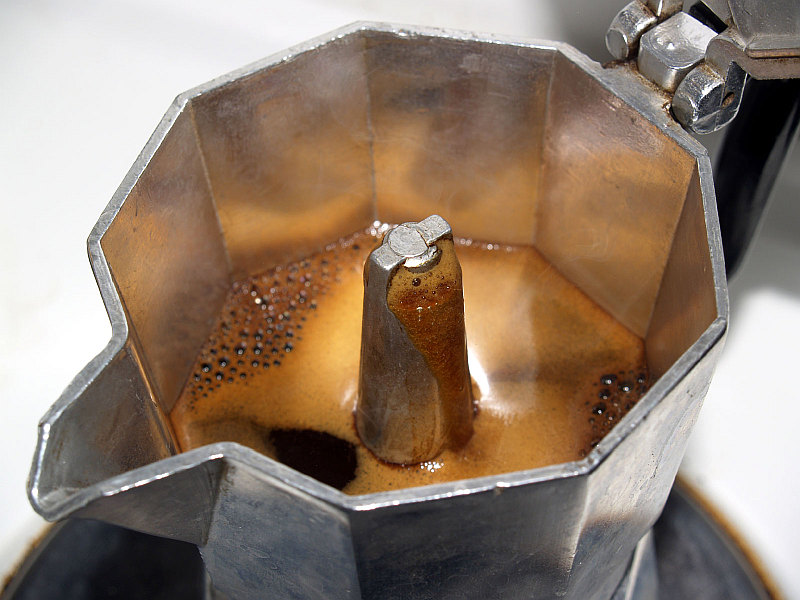
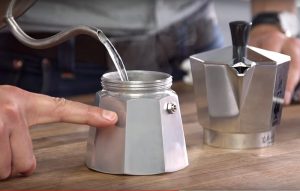
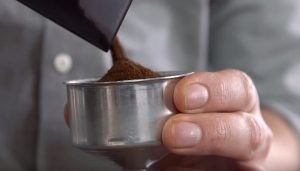
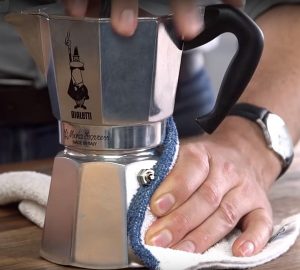
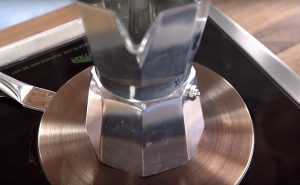
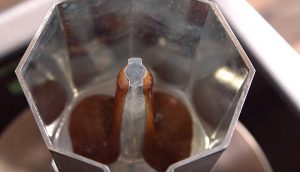
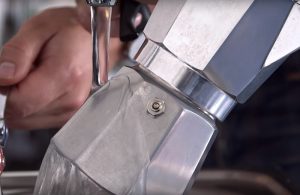
You must be logged in to post a comment.